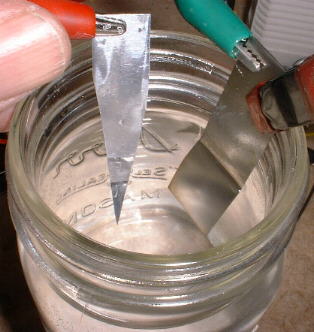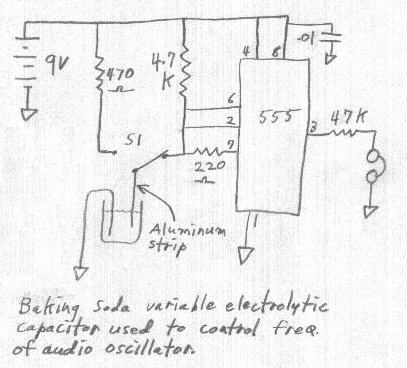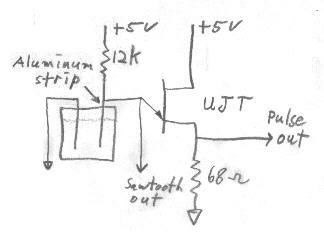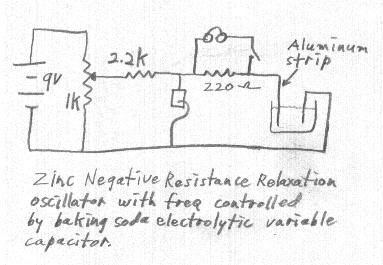

This capacitor of course must be used, as with any electrolytic capacitor, with a positive DC bias on the aluminum plate. Although one would not expect great leakage specs from this capacitor, I found it to be quite useful in practical situations such as for controlling the frequency of a very wide range relaxation oscillator.
As far as I know, nothing like this has ever been available or even manufactured. most variable capacitors are the type used for tuning radios and they rarly have capacitance values above 365 pf and their ratio of variation is not much better than ten to one. We are able to make here a variable capacitor with a capacitance variation range of 5000 to one and with max values of 10 uf or more.
The schematics below show different types of relaxation oscillators with their frequency determined by the value of the variable electrolytic capacitor. One is based on the 555 timer chip. Another is based on a UJT transistor. The choice of circuit is based merely on parts availibility although it is easier to obtain a wider frequency range with the 555. For those who are really adventurous, a zinc negative resistance relaxation oscillator can be built and is also shown (see Zinc Negative Resistance Oscillator).
The capacitor is easily made by putting two electrodes into a solution of baking soda. One electrode must be aluminum but the other can be just about anything that conducts electricity such as lead, steel, stainless steel or even carbon. In the picture above, a piece of stainless steel sheet is used for the electrode opposite the aluminum. Both electrodes can be aluminum if you want to make a capacitor capable of working with ac voltages. The electrode opposite the aluminum is kept immersed into the solution while the aluminum electrode is moved in and out of the solution to vary the capacitance.
When the aluminum is first dipped into the solution, it causes a short to ground through the solution. To form the capacitor, the aluminum plate is connected to a positive supply (S1 in the case of the 555 circuit) through a 470 ohm resistor. The aluminum plate should at this time be dipped most of the way into the solution and swished around for about 20 seconds while a thin film of aluminum oxide forms on it. The aluminum plate becomes the positive side of the capacitor. The aluminum strip is then switched back to the oscillator circuit (using S1). S1 is omitted in the UJT and negative resistance circuits for clarity but the requirements for forming the capacitance are the same as with the 555 circuit.
The oscillator is most likely to start running when the aluminum strip is dipped a very short distance into the liquid. The frequency may be out of hearing range and you may need a scope to determine if it is running. The frequency will get lower as the strip is dipped farther into the solution until the leakage becomes great enough to make the oscillator stop. As the aluminum strip is repeatedly dipped in and out, the capacitance and frequency range seem to improve until the strip can be dipped almost its entire length creating the greatest frequency variation range. With the 555 circuit, I was able to make continuous frequency sweeps from 10hz to 100khz.
If the electrode opposite the aluminum is slid in or out of the solution, very little effect on frequency is noticed. This shows that the capacitance is happening at the aluminum electrode (strip).


